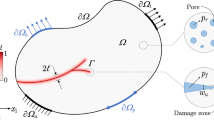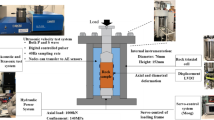Abstract
The ice sheet is characterized by the development of fracture structures on a local and regional scale with the participation of fracture processes that occur at different scales, differing from each other by several orders of magnitude. The analysis shows that it is possible to distinguish a class of materials, which, in particular, include sea ice and other granular and structured materials (gypsum, concrete, paraffin, etc.), the effective fracture toughness of which during brittle fracture is affected by a large-scale factor, the role of which a gradient of external stresses appears. A model of this phenomenon is proposed for situations associated with variations in the local stress gradient with a change in the scale of the fracture region. Using the example of sea ice cover, we estimated the impact of the effect on the destruction scenarios of structured media.
Similar content being viewed by others
References
V. V. Lavrov, Ice Deformation and Strength (Gidrometeoizdat, Leningrad, 1969) [In Russian].
C. G. Hoover and Z. P. Bazant, “Cohesive Crack, Size Effect, Crack Band and Work–of Fracture Models Compared to Comprehensive Concrete Fracture Tests,” Int. J. Fract. 187 (1), 133–143 (2014).
B. Frigo, A. P. Fantillia, and B. Chiaia, “Size Effect on Fracture Toughness of Snow,” in Proc. of XXIV Italian Group of Fracture Conference, 1–3 March 2017, Urbino, Italy (Procedia Structural Integrity, 2017), pp. 261–268.
K. P. Tyshko, N. V. Cherepanov, and V. I. Fedotov, Crystal Structure of Sea Ice Cover (Gidrometeoizdat, St. Petersburg, 2000) [In Russian].
R. V. Goldstein, V. M. Ladygin and N. M. Osipenko, “A Model of the Fracture of a Slightly Porous Material under Compression or Tension,” Fiz.-Tekh. Probl. Raz. Polez. Isk, No. 1, 3–13 (1974) [J. Mining Sci. (Engl. Transl.) 10 (1), 1–9 (1974)].
R. V. Goldstein, “Fracture in Compression,” Usp. Mekh. 2 (2), 3–20 (2003).
R. V. Goldstein and N. M. Osipenko, “Some Questions on Ice and Ice Cover Fracture in Compression,” In: Icestructure Interaction. IUTAM-IAHR Symp. St. John’s, New Foundland, Canada, (Springer-Verlag, Berlin, Heidelberg, 1991), pp. 251–266.
E. Z. Lajtai and V. N. Lajtai, “The Collapse of Cavities,” Int. J. Rock Mech. Min. Sci. Geomech. Abstr. 12, 81–86 (1975).
R. V. Goldstein and N. M. Osipenko, “Some Aspects of Strength in Sea Ice Mechanic,” Fiz. Mezomekh. 17 (6), 59–69 (2014) [Phys.Mesomech. (Engl. Transl.) 18 (2), 139–148 (2015)].
G. W. Timko and R. M. W. Trederking, “Compressive Strength of Ice Sheets,” Cold Reg. Sci. Tech. 17, 227–240 (1990).
J. Schwarz and W. F. Weeks, “Engineering Properties of Sea Ice,” J. Glaciology 19 81, 499–531 (1977).
R. V. Goldstein and N. M. Osipenko, “Fracture Mechanics and Several Problems of Ice Fracture,” in Mechanics and Physics of Ice (Nauka, Moscow, 1983), pp. 65–94 [in Russian].
J. P. Dempsey, R. M. Adamson, and S. V. Mulmule, “Scale Effects on the In-Situ Tensile Strength and Fracture of Ice. Part II: First-Year Sea Ice at Resolute, NWT,” Int. J. Fracture 95 (1), 347–366 (1999).
J. P. Dempsey, S. J. DeFranco, R. M. Adamson, and S. V. Mulmule, “Scale Effects on the In-Situ Tensile Strength and Fracture of Ice. Part I: Large Grained Freshwater Ice at Spray Lakes Reservoir, Alberta,” Int. J. Fracture 95 (1), 325–345 (1999).
J. Dempsey, D. M. Cole, and S. Wang, “Tensile Fracture of a Single Crack in First-Year Sea Ice,” Phil. Trans. Royal Soc. A: Math. Phys. Engng Sci. 376, (2129):20170346, September 2018. https://doi.org/10.1098/rsta.2017.0346.
J. P. Dempsey, “Research Trends in IceMechanics,” Int. J. Sol. Struct. 37, 131–153 (2000).
C. A. Totman, O. E. Uzorka, J. P. Dempsey, and D. M. Cole, “Sub-Size Fracture Testing of FY Sea Ice,” in Proceedings of the 6th International Conference on Fracture Mechanics of Concrete and Concrete Structures, Catania, Italy, 17–22 June 2007, Vol. 3, pp. 1683–1690.
J. P. Dempsey, Y. Xie, R. M. Adamson, and D. M. Farmer, “Fracture of a Ridged Multi-Year Arctic Sea Ice Floe,” Cold Reg. Sci. Techn. 76–77, 63–68 (2012).
G. P. Cherepanov, Mechanics of Brittle Fracture (Nauka, Moscow, 1974; McGraw-Hill, New York, 1979).
V. M. Vainshelbaum and R. V. Goldstein, “On the Material Scale Length as a Measure of Plastic Material Fracture Toughness and its Meaning in the Fracture Mechanics,” Preprint No. 77, Institute for Problems in Mechanics, The USSR Academy of Sciences, Moscow (1976).
Z.P. Bazant and J. Planas, Fracture and Size Effect in Concrete and Other QuasibrittleMaterials (CRC Press, Boca Raton, 1998).
Z.P. Bazant, “Size Effect in Blunt Fracture: Concrete, Rock, Metal,” ASC. J. Engng Mech. 110, 518–535 (1984).
K. Duan, X.-Z. Hu, and F. H. Wittmann, “Size Effect on Fracture Resistance and Fracture Energy of Concrete,” Mat. Struct. 36 (3), 74–80 (2003).
S. V. Suknev, “Nonlocal and Gradient Ffracture Criteria for Quasi-Brittle Materials under Compression,” Phiz. Mezomekh. 21 (4), 22–32 (2018)
E. Z. Lajtai, “Effect of Tensile Stress Gradient on Brittle Fracture Initiation,” Int. J. Rock Mech. Min. 9 (5), 569–578 (1972).
M. A. Legan, “On the Relationship Between the Gradient Criteria for Local Strength in the Region of Stress Concentration and the Linear FractureMechanics,” Prikl. Mekh. Tekhn. Fiz. 34 (4), 146–154 (1993).
M. D. Novopashin and S. V. Suknev, “Gradient Criteria of Limit State,” Vestn. SamGU Est. Ser., No. 4 (54), 316–334 (2007).
Z. P. Bazant, “Size Effect in Blunt Fracture: Concrete, Rock, Metal,” ASC. J. Engng Mech. 110, 518–535 (1984).
Stress Intensity Factors Handbook Ed. by Y. Murakami, (Pergamon Press, Oxford, 1987; Mir, Moscow, 1990).
Z. P. Bazant, M. T. Kazemi, T. Hasegawa, and J. Mazars, “Size Effect in Brazilian Split-Cylinder Tests: Measurments and Fracture Analysis,” ACI Materials J. 88, 325–332 (1991).
V. V. Bogorodskii and V. P. Gavrilo, Ice (Gidrometeoizdat, Leningrad, 1980) [in Russian].
S. P. Timoshenko and J. N. Goodier, Theory of Elasticity (McGraw, New York, 1970; Nauka, Moscow, 1975).
R. V. Goldstein and N. M. Osipenko, “On a Model of Structured Medium Fracture under Compression Conditions,” Izv. Ros. Akad. Nauk. Mekh. Tv. Tela, No. 6, 86–97 (2010) [Mech. Sol. (Engl. Transl.) 45 (6), 835–843 (2010)].
G. W. Timco and S. O’Brien, “Flexural Strength Equation for Sea Ice,” Cold Reg. Sci. Tech. 22, 285–298 (1994).
Ch. Pen, “Experimental Studies and Analysis of the Characteristics of Sea Ice Flexural Strength along the Coast of the Gulf of Bohai,” Mol. Uch. 27, 39–46 (2017).
I. Dykins, “Tensile and Flexural Properties of Saline Ice,” in Proc. Int. Symp. on Physics of Ice (Munich, 1968), pp. 9–14.
Acknowledgement
This work was financially supported by the program of the Presidium of the RAS No. I.2.55P: “The Arctic—scientific foundations of new technologies for conservation and development”.
Author information
Authors and Affiliations
Corresponding author
Additional information
Russian Text © Author(s), 2019, published in Izvestiya Akademii Nauk, Mekhanika Tverdogo Tela, 2019, No. 5, pp. 70–85.
About this article
Cite this article
Osipenko, N.M. On the Scale Dependence of Cracking Resistance of Structured Solids (on the Example of Marine Ice Cover). Mech. Solids 54, 1051–1062 (2019). https://doi.org/10.3103/S0025654419070069
Received:
Revised:
Accepted:
Published:
Issue Date:
DOI: https://doi.org/10.3103/S0025654419070069




